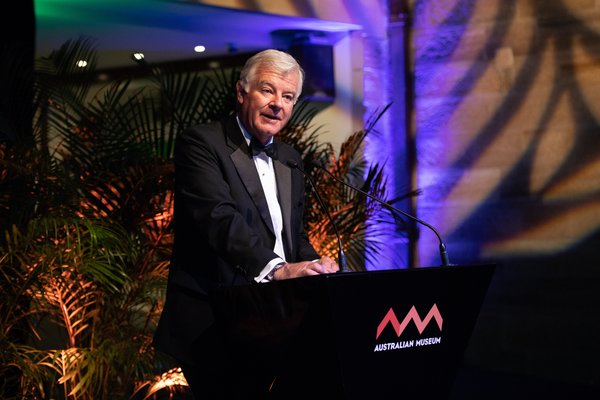Vale Michael R.B. Gray, former Australian Museum Arachnologist
In late August 2023 we sadly farewelled a former colleague, arachnologist Dr Michael Gray, who passed away at the end of July, age 81 years. Mike joined the Australian Museum in early 1968 and essentially built up the Arachnology collection we have today, which ranks among the largest in the Southern Hemisphere.
When Mike started at the Museum as Assistant Curator (Arachnology), spiders and the other arthropod groups now comprising the Arachnology collection formed a fairly small and rather neglected subset of the Entomology collections. Mike soon introduced modern curatorial techniques and standards and with aid of an assistant, started databasing specimens in 1977. By Mike’s retirement in 2009, the number of databased specimen lots was over 109,000.
Mike enthusiastically embarked on an extensive field collecting programme to grow the Museum collections and sample habitats throughout the state and further afield. Later, he was involved with many significant surveys such as World Heritage Rainforests (with the Queensland Museum), Lord Howe Island, and the North East Forests Biodiversity Survey (with NSW National Parks and Wildlife Service). Today, almost 11,000 specimen lots are registered in the AM database with Mike listed as collector.

© Australian Museum
Of course, if your name is on so many specimen labels as a collector, you end up with specimens named after you. Mike accrued an impressive tally of 23 spider specific patronyms and 2 spider genera, Grayenulla Zabka 1992 and Graycassis Platnick 2000 (also named after Gerry Cassis, who worked with Mike on the North East Forests survey). Many of Mike’s collections also contained animals other than spiders, so there may well also be patronyms among species of insects and other terrestrial invertebrates that I haven’t been able to track down.
An important part of Mike’s role as a public service employee was always public engagement. Public interest in spiders has always been high, and Mike fielded a heavy load of public enquiries, talks, magazine articles and a very successful in-house production of the Spiders! Exhibition in 1997. Alongside all this, Mike also served a lengthy stint as the Head of Division of Invertebrate Zoology. Many staff remember Mike as a caring and considerate boss, who would always make time to work through your issues.
Through the years, Mike somehow managed to find time to carry on an active research programme, and as public service roles changed over the years, he moved from a mixed curatorial remit into a Research Scientist position, moving up through the ranks to become a Principal Research Scientist in 2003. One of Mike’s initial and enduring research interests was in cave spiders, in fact many of his published generic reviews contained at least one troglobite or troglophile – a species that may have originally piqued his interest in the group. Of the 140 genera and species authored or coauthored by Mike, 17 species were taxa found in caves and five new genera were only known from caves (although one of these now also has epigean species described). This may not sound like many, but cave spiders often exist at a low density and can be difficult to find as adults – so it is actually quite a notable achievement.

© Australian Museum
Two other research projects that were not cave related but had considerable impact were Mike’s work on funnel-web spiders, and his collaboration with medical doctor Geoff Isbister on spider bites. The revision of Australian funnel-web spiders (now in their own family, the Atracidae) was the subject of Mike’s PhD project, which he completed in 1986. However, Mike knew that there were ‘issues’ with variation in characters in some populations, issues that he could not resolve within the framework of his PhD studies. So instead of publishing straight away, he held off, hoping to get further clarification as technology improved the range of tools available to him. As often happens, though, other projects were by then demanding more urgent attention and the funnel-webs were put to one side, not to be published until 2010. Despite the delay in publication, Mike’s knowledge of funnel-web spiders enabled him to contribute greatly to the dissemination of information on this medically important group.
The spider bites project resulted in a series of five papers co-authored with physician Geoff Isbister. Dr Isbister arranged with medical facilities around Australia to retain specimens brought in by bite patients who presented with the spider that had bitten them. Mike identified the specimens, and it then became possible to link species to symptoms. Through this, the pervasive myth of the flesh-eating necrosis supposedly caused by the bite of Australian White-tailed spiders (Lampona spp.) was laid to rest. This White-tailed Spider bite paper saw Isbister and Gray nominated as Eureka Finalists in 2004 for the Australian Skeptics Eureka Prize for Critical Thinking.
Over the years, Mike supervised a number of Honours, Masters, and PhD students and was an Honorary Associate in the Faculty of Science and the Faculty of Agriculture Food and Natural Resources at Sydney University from around 2000 until 2006. He was also mentor to Graham ‘Wishy’ Wishart, a retired pharmacist who took an interest in the trapdoor spiders and other wandering mygalomorphs that fell in his swimming pool. With Mike’s encouragement and guidance, Wishy published several papers on the trapdoor spider fauna of New South Wales.
Mike retired in 2009 and his final publication was as a co-author in 2022. Mike leaves behind him a substantial legacy of work across many unique southern taxa and he was a pioneer of cave spider research in Australia. Through his unpublished notes and through the training, mentorship and encouragement of others, his contributions to Australian arachnology will continue for many years.
More information:





